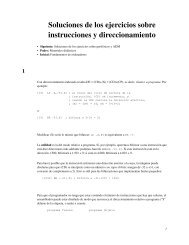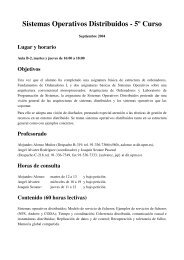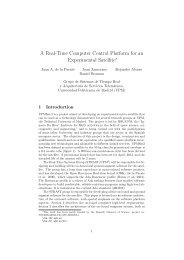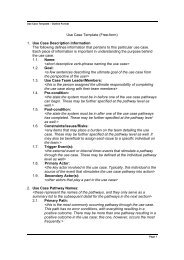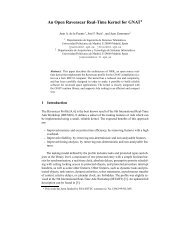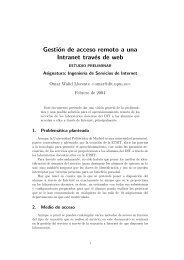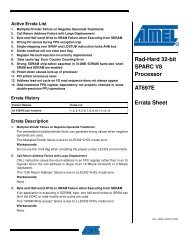Real-Time Programming with GNAT - DIT - Universidad Politécnica ...
Real-Time Programming with GNAT - DIT - Universidad Politécnica ...
Real-Time Programming with GNAT - DIT - Universidad Politécnica ...
Create successful ePaper yourself
Turn your PDF publications into a flip-book with our unique Google optimized e-Paper software.
schemes in the literature, none of them fitting all thedifferent kinds of applications. Therefore we have tried toestablish a flexible framework to allow the user toimplement the scheduling policy that is really needed.3. ImplementationWhen thinking about developing a real-time application,one of the most difficult aspects is bounding the worst-caseexecution time (WCET). To obtain analytically a tightmeasurement of this value, two issues are very important:to have access to the source code (application, run-timelibraries and operating system) and to work <strong>with</strong> animplementation as simple as possible. Since we areworking <strong>with</strong> <strong>GNAT</strong> the source code is accessible (ourlibraries and kernel are also free software), and simplicityis the most important issue that we have had in mind in ourdesign.The low-level task management exerts a high influenceon the overall behaviour of the whole system. Tasks changetheir execution states frequently and it is important toperform these actions in a predictable and efficient manner.In our implementation the ready tasks are kept in a queuesorted by priorities. When a task enters or exits the readystate, the system must insert or remove the task from theready queue. All ready queue operations are executed infast, bounded time, <strong>with</strong>out need for search loops. In ourlibrary the kernel and tasks run in the same address space.It allows task switching to be very fast, and eliminates theneed for system call traps.Signal management is an important issue for improvingPthreads behaviour. GNARL has a very specific way ofmanaging signals[7], similar in many senses to the wayused by Pthreads. What happens is that GNARL doesalmost all the job on its own, and uses the low level supportin a minimal mode. Since Pthread does not offer thepossibility of a reduced use there is a lot of redundant andcomplex processing that obscures the measurement of thekernel metrics. Our approach is to notify the GNARL layerof the occurrence of the signal and let this layer process thesignal. All the low-level management has been reduced to aminimum. There is a table <strong>with</strong> a one-to-onecorrespondence between the waiting tasks and their relatedsignals, leading to a very simple and efficient signaldelivery model.As for the timer support, we have modified the GNARLlayer so that only one timer request can be issued at a time(using a timer server task). Therefore the underlying librarydoes not have to deal <strong>with</strong> more than one simultaneousrequest. This simplification leads to reducing the overheadinvolved in managing different queues, and to an easierway of understanding what these layers do. This alsomakes it easier to bound execution times. Moreover, theway used to program the timer is very similar to the way itis done in RT-Linux[10], achieving microsecond resolutiontimers.The implementation of Ada ATC (AsynchronousTransfer of Control) in GNARL is based on per-threadsignals (when it is layered over Pthreads). If we are usingJTK for low-level support the design can be simplified. Aswe have access to the saved state of the target task, andconsequently its program counter, we can change this stateto redirect control. The target task will begin the transfer ofcontrol as soon as it is next scheduled to execute.4. PerformanceTo evaluate the performance of this implementation wehave tested two kinds of programs as a first attempt:1. Two tasks which only perform context switches.The times reported are averages taken over 100000 iterations of each task.2. Two tasks executing 100 loops inside which theyperform a select statement <strong>with</strong> a delayalternative. The measurements indicate theamount of processor time that a third task coulduse normalized to the maximum value obtained.In this way, changing the value of the delayalternative produces results which are of the sameamount.The tests have been executed on the same machine(Pentium II at 233 MHz). The measurements have beentaken over three different <strong>GNAT</strong> implementations:1. <strong>GNAT</strong> 3.10p over JTK.2. <strong>GNAT</strong> 3.10p over Linux, using the FSUimplementation of Pthreads.3. <strong>GNAT</strong> 3.10p over DOS, using the FSUimplementation of Pthreads.Context switch time is a very important feature in realtimesystems, <strong>with</strong> a high influence on timing behaviour.The notion of cheap concurrency has been around inPthreads and related works, which try to offer lightweightprocesses. Figure 2 shows the results of the first test, fromwhich we can see that there is an increase of 170% ofefficiency in context switch time <strong>with</strong> respect to the Linuximplementation, and of 300% compared to the DOSimplementation.



